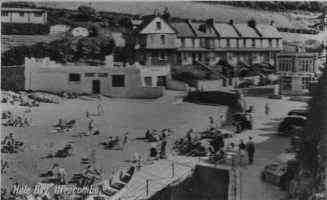 After WW2, Hele
Beach became very popular, as can be seen in these photographs (left and
below right). The camp site by the beach was
advertised
After WW2, Hele
Beach became very popular, as can be seen in these photographs (left and
below right). The camp site by the beach was
advertised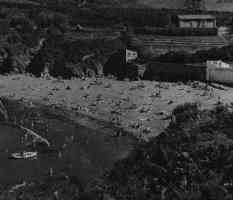 in the Ilfracombe Guide and there was sufficient
trade to support two beach-side Cafe's; Nat Lewis' Cafe (now
Bayside Cafe), and the Fort Cafe, which was run by Molly Greatwich (known
as Aunt Molly) until 1964, when it was sold to George Banks. Mr Banks
then bought Nat Lewis', and the Fort Cafe became an amusement arcade, containing slot machines
and an Edwardian Roadster. It became a dive hire shop in 1991,
which lasted only one season, and it has not been used since. Another Cafe opened at 12
Beach Road in the 1970's but was converted back into a private house in 1995. The promenade benches
were
removed during the war and the promenade used for parking cars until the
benches were replaced in the 1980's. (1)
in the Ilfracombe Guide and there was sufficient
trade to support two beach-side Cafe's; Nat Lewis' Cafe (now
Bayside Cafe), and the Fort Cafe, which was run by Molly Greatwich (known
as Aunt Molly) until 1964, when it was sold to George Banks. Mr Banks
then bought Nat Lewis', and the Fort Cafe became an amusement arcade, containing slot machines
and an Edwardian Roadster. It became a dive hire shop in 1991,
which lasted only one season, and it has not been used since. Another Cafe opened at 12
Beach Road in the 1970's but was converted back into a private house in 1995. The promenade benches
were
removed during the war and the promenade used for parking cars until the
benches were replaced in the 1980's. (1)
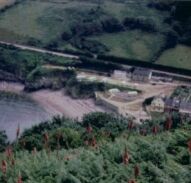 In 1961 the Annear's, then owners of the campsite by the beach, obtained
permission to site static caravans, and sold the site to Arthur Penzer; he
created the terraces (left) and sited some caravans, before selling it on
to George and Shirley Bank's in 1964. They developed Beachside with
home-
In 1961 the Annear's, then owners of the campsite by the beach, obtained
permission to site static caravans, and sold the site to Arthur Penzer; he
created the terraces (left) and sited some caravans, before selling it on
to George and Shirley Bank's in 1964. They developed Beachside with
home-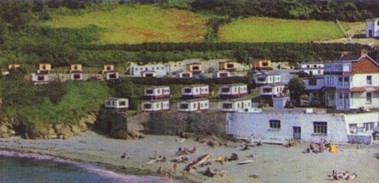 made caravans, called chalivans
(right) and after nearly 20 years, sold it
to Ashton Steel Stockholders, who replaced the chalivans with static caravans. It was run under the management of Arthur and Winnie Campbell until
1997 when it was bought by John & Melanie Moore, who upgraded many of the
caravans and rebuilt the main entrance and many dry-stone walls before selling
the site to the Crocket's in 2003. (2)
made caravans, called chalivans
(right) and after nearly 20 years, sold it
to Ashton Steel Stockholders, who replaced the chalivans with static caravans. It was run under the management of Arthur and Winnie Campbell until
1997 when it was bought by John & Melanie Moore, who upgraded many of the
caravans and rebuilt the main entrance and many dry-stone walls before selling
the site to the Crocket's in 2003. (2)
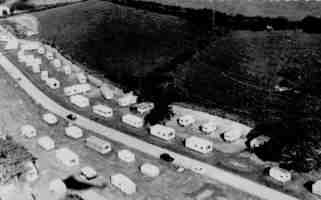 It is said that there was camping at Hele Valley from 1947
and in the early 1960's, probably soon after the gas works closed in 1962, a Mr
Devine, who lived at Moles Farmhouse, obtained permission to site caravans
there. He created the terracing (left) which followed the
line of the old mill leat. He sold Hele Valley to the present owner's, David and
Sandra Dovey, in 1970. This photograph of Hele Valley (below right) shows
camping in the top field (now discontinued) and the gas holders. (3)
It is said that there was camping at Hele Valley from 1947
and in the early 1960's, probably soon after the gas works closed in 1962, a Mr
Devine, who lived at Moles Farmhouse, obtained permission to site caravans
there. He created the terracing (left) which followed the
line of the old mill leat. He sold Hele Valley to the present owner's, David and
Sandra Dovey, in 1970. This photograph of Hele Valley (below right) shows
camping in the top field (now discontinued) and the gas holders. (3)
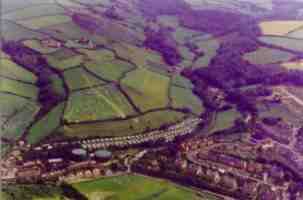 Hele Bay Holiday Flats
are said to have been built at the end of the 1960's, after the gas works had
closed. They were originally used for holiday letting, but are now mostly in residential
use. The two gas holders were removed around the late
1980’s. By then, the former gas works had became a business park and one of
its first occupiers was North Devon Fuels, owned by Len Boudier,
who later opened Hele Building Supplies in the main building. (4)
Hele Bay Holiday Flats
are said to have been built at the end of the 1960's, after the gas works had
closed. They were originally used for holiday letting, but are now mostly in residential
use. The two gas holders were removed around the late
1980’s. By then, the former gas works had became a business park and one of
its first occupiers was North Devon Fuels, owned by Len Boudier,
who later opened Hele Building Supplies in the main building. (4)
The Congregational Chapel, built in 1913, was converted to a private house, called Val-de-Rio, in the 1970's. The National school, built in 1865, resisted closure several times in the 1950's but with so few pupils (nine in 1957) it finally succumbed to the inevitable. After being derelict for a while, it too was converted into a private house. (5)
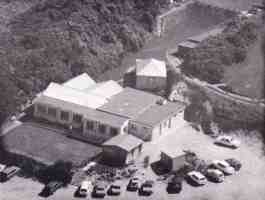 In 1962 an electric generator was installed at Ilfracombe Golf Club and in
1966 the Club purchased the site from the landowner, Mrs Watts. The pavilion
continued to be extended, as can be seen in this photograph from 1975 (left) and a water supply was installed, supplied by a borehole. In 1989 a
freak storm destroyed much of the clubhouse and it had to be substantially
rebuilt (below right) (6). The storm also affected the caravan sites: at
Beachside, a caravan was blown right off the cliff!
In 1962 an electric generator was installed at Ilfracombe Golf Club and in
1966 the Club purchased the site from the landowner, Mrs Watts. The pavilion
continued to be extended, as can be seen in this photograph from 1975 (left) and a water supply was installed, supplied by a borehole. In 1989 a
freak storm destroyed much of the clubhouse and it had to be substantially
rebuilt (below right) (6). The storm also affected the caravan sites: at
Beachside, a caravan was blown right off the cliff!
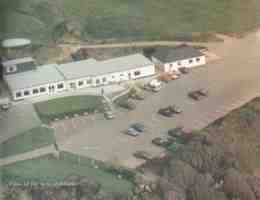 Chambercombe Manor became a tourist
attraction in 1972, although previous occupants had provided guided tours as far back as
the 1930's. Several outbuildings have since been converted into holiday cottages
and a tea room. In 1973 Hele Mill was bought by Chris Lovell who restored the
building and mill workings, installed new millstones, a diesel engine to
drive the mill when there was no water and opened to the public in 1978. The Gray's bought the mill in 1995 and added a
pottery and a tea rooms. (7)
Chambercombe Manor became a tourist
attraction in 1972, although previous occupants had provided guided tours as far back as
the 1930's. Several outbuildings have since been converted into holiday cottages
and a tea room. In 1973 Hele Mill was bought by Chris Lovell who restored the
building and mill workings, installed new millstones, a diesel engine to
drive the mill when there was no water and opened to the public in 1978. The Gray's bought the mill in 1995 and added a
pottery and a tea rooms. (7)

In the early 1970's the bend in the main road, known as Hockey Corner, was straightened out. A photograph from c1962 (left) shows the previous route. The old bit of road is still there and occasionally used by Council contractors for storage. At around the same time, the allotments in Beach Road were bought by the Council, who built the car park. In the late 1970's, some of the 14 council houses on Upper Hillside Road (below left) were scheduled for demolition due to subsidence, but following a land-slip in February 1980, which encroached upon the houses in Hillside Road below, they were all demolished, making 13 families temporarily homeless. Upper Hillside Road is now an orchard and the only remaining traces are the walls and hedges, much overgrown, of the houses' rear gardens. (8)
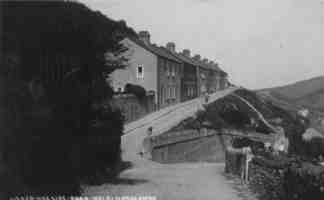
In 1974, Ilfracombe Swimming Pool was opened beside Brimlands. In the 1970's and 1980's there was a tidal paddling pool on Hele Beach (below left). This photograph also shows the old steps up Hillsborough, closed around the late 1970's, new steps were made a little inland. The tidal pool is said to have been removed because it was partly fed by the stream, which passes through several farms, and can become contaminated. Although it is now regularly tested, bathers would still be advised to keep away from the stream. (9)
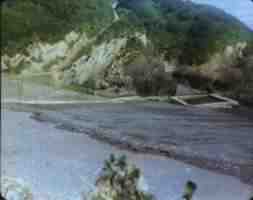 In 1993 Hillsborough was designated a Nature Reserve. A report suggested
that the bracken be poisoned and the hillfort be grazed, but this was resisted by local
people who formed Hillsborough Interest Group of Helpers (HIGH) in 1995 to
manage Hillsborough themselves. This group is now more or less in abeyance. In
2000 a further report, considering the archaeology of Hillsborough, recommended
that the hillfort be enclosed and grazed, and that the Volunteer battery be recorded before it
disappears. (10)
In 1993 Hillsborough was designated a Nature Reserve. A report suggested
that the bracken be poisoned and the hillfort be grazed, but this was resisted by local
people who formed Hillsborough Interest Group of Helpers (HIGH) in 1995 to
manage Hillsborough themselves. This group is now more or less in abeyance. In
2000 a further report, considering the archaeology of Hillsborough, recommended
that the hillfort be enclosed and grazed, and that the Volunteer battery be recorded before it
disappears. (10)
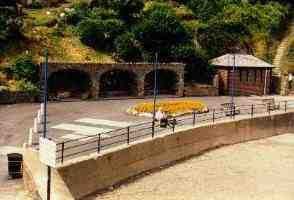
In 1994, South West Water installed a pumping station on the promenade to
pump effluent to the new sewage treatment plant at Larkstones. Before that, raw
sewerage went out to sea under Donkey Island. This photograph (right) shows the promenade just before the pumping station was built (to the
left hand side of the toilet block). To the right are the new steps up
Hillsborough. The benches were 'put back' in the 1980's and a new bench was
added in 2001, inscribed with a hockey stick and the words "In memory of Hazel
Baker and Tanzi". Hazel lived in Beach Road and was often to be seen on the
beach, with her dog Tanzi, for whom she used to knock a ball with a hockey stick.
This photograph (below left) shows contractors
working on the holding tank under the promenade. This work was clearly
worthwhile; in 2002 and 2003, Hele Beach won a Seaside
Award for clean bathing water and good beach management.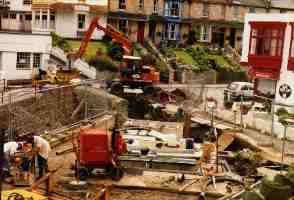
(1) Fort Cafe, Bayside Cafe
The 1948 Ilfracombe Guide has an advert for the Fort Cafe (as the 1946 & 1937/8/9 guides) and there is a picture of Hele Beach, first seen in this year, shown above (Ilfracombe Museum, Ilfracombe Guide 1948)
The other photograph of Hele Beach, the Fort Cafe and Lewis', shown above, is from a postcard that says on the front "Hele Bay, Ilfracombe 1701" and on the back "Photo-precision ltd, St Albans, this is a genuine photograph" (A Galliver) It is probably of similar date to that of 1948.
"This pretty little village [Hele] lies in a hollow one mile and a half from the Post Office [in Ilfracombe]. Proceed...to the Thatched Cottage, and then keep straight on and down the hill to the Hele Bay Hotel where turn left down to the bathing beach, a rendezvous well worth while for sun and sea bathing. Teas and refreshments at the Fort Cafe. After this proceed from the beach straight up the Hillsborough cliff path, turn left and keeping to the path round the hill go down beside the recreation ground, turn left and then right beside the tennis court and putting greens" (Wood 1957? p 11)
February 21st 1967 - Change of use from beachside cafe to amusement arcade granted ND1853 Cafe trade transferred to cafe opposite there being insufficient trade for 2 cafes (NDDC Planning Department)
August 25th 1978 - Proposed change of use from amusement arcade to function/entertainment centre, objected to by local residents who raised a petition, refused (LA search 1997)
September 24th 1991 - Change of use ND13334 from amusement arcade to boat & dive hire shop granted (NDDC Planning Department)
1970 - 12 Beach Road converted to a restaurant. (Campbell 1986) Converted back to a house about 1995.
(2) Beachside
April 1960l - Caravan Sites guide 1960/1 - "ILFRACOMBE (1m) Adjoining Hele Beach Ilfracombe, Tel Ilfracombe 17, Owner Mr J Annear, 109 High Street, Ilfracombe (Caravan Sites, the Heathcock Press, Strand, London April 1960 p 40)
January 10th 1961 - Planning application ND873 granted for 22 static caravans (NDDC Planning Department) June 2nd 1961 - Planning permission ND906 granted for toilet block and 28 caravans (NDDC Planning Department)
September 29th 1961 - Conveyance of Fort cafe, Hele Bay Caravan Site and ‘Beachside’ house from Alice Annear (for John Kelly deceased) to Arthur James Penzer for £8,000 (J Moore deeds)
A transparency dated Jan 1963, taken summer 1962 (Mr Pinfield) shows Beachside holiday park soon after the terracing has been created, shown above.
February 6th 1964 - Arthur Penzer acknowledges receipt of £3000 for 10 caravans and £1750 for fixtures and fittings. February 21st 1964 - Conveyance Arthur Penzer (of Beachside Hele) to Chalivan Parks Ltd (reg office Beachside, George Ernest & Shirley Banks) of Beachside, Fort Cafe and Hele Bay Caravan Park for £12,000 (J Moore deeds) . Penzer didn’t do too badly, he bought for £8K, terraced the site, built the toilet block, sited 10 caravans and sold for nearly £17K after 3 years.
A colour photograph of Beachside Chalivan Park, taken c1974, of which a detail is shown above, is copied from a 1978 Brochure (Beachside Holiday Park). There is a black and white copy in the Ilfracombe Guide of 1975; a colour version was used in an advert in the Ilfracombe Guide from 1977-1997.
(3) Hele Valley
1947- Hele Valley Holiday Park opened (Campbell 1986 p 18)
Mr Dovey moved to Hele Valley in 1970. The previous owner, Mr Devine, had owned Moles Farmhouse and Hele Valley since 1964-5: he terraced the valley and sited the first caravans. Before that the valley, the Farmhouse and the mill were owned by Mr Briggs (D & S Dovey, Hele Valley)
The postcard of Hele Valley, shown above, was taken soon after the site was terraced. It has "Moles Farm Caravan Park Hele Bay, Ilfracombe" on the back (Hele Valley Holiday Park). The cutting roughly followed the line of the mill leat.
The other picture of Hele Valley above, with camping in the top field and the two gas holders is from c1975 (Hele Valley Holiday Park)
(4) Gas works, Hele Holiday Flats, Business Park
1955 - Ilfracombe replaces gas street lights with electricity at a cost of £9,282 (IMN 2000 p 18)
1962 - Gas works in Hele closed although gas holders still in use in 1986 (Campbell 1986 p 25)
The Gas Works was closed down in 1972, and is now used for a coal yard, workshops for the Youth Opportunities Schemes, etc. and Manpower Services. (ICTG 1985-6 p 5)
1969/70 - Hele Bay Flats built (Campbell 1986 p 18)
(5) Chapel & School
"MINISTER SAVES 9-PUPIL DEVON SCHOOL, Demand for closure twice refused. Hele's infants' School and its nine pupils have found a champion in its fight to remain open: the Minister of Education. Twice the Devon education authorities have tried to close the little school in the village near Ilfracombe, and twice the Minister has refused. The North Devon Education Executive was told this at Barnstaple yesterday "The Ministry of Education is saying: We have £1,000 to throw away and we might as well throw it away at Ilfracombe" complained Ald. C F Dart. Mr C N Pedlar brought up the case of the Voluntary Controlled Infants' School when he said "How much longer is this school going to continue with seven pupils costing £7 to £8 a week to teach? I think it is high time we have something to say to the Minister about whether it is going to be closed, and say that we think it ought to be closed". "I agree with you" said the Chairman Mr B G Lampard-Vachell. "The County Council agreed with us that it ought to be closed, but to our surprise the ridiculous thing was they decided not to close it". "We should have something to say about the cost" said Mr Pedlar. "That's what we are here for". "I don't think that you will get any change from the Minister", said the chairman. "I saw Mr Vosper when he was with the ministry and told him this was utter nonsense. He said he would look into the case". Mr F J Richards said he thought the school would cost nearly £1,000 a year to keep open. Nine pupils sat doing handiwork in the school's one classroom, under the guidance of Mrs I M Fogg, yesterday. Gas lights hung from the roof and in the corner was the schools first toy: a rocking horse bought at a jumble school. The school was built in 1865. "It would be dangerous to send the pupils to Ilfracombe" said an official who favoured the school's retention. "The parents in the area are unanimous against its closure and formed a petition when it was last threatened.. Anyway, the children would never get the individual attention they have here anywhere else; it is like a little family. They are very happy. If parents knew the school would stay open, more would send their children here". The matter is to be investigated by the Executive's Secondary Education Sub-Committee" (Western Morning News, July 9 1957, copy of article in Hele box, Ilfracombe Museum). The article has a picture with the caption "M Fogg, the headmistress taking a lesson with the nine pupils of Hele Infants' School, Ilfracombe, yesterday" This has a photograph taken inside the school, when occupied (Western Morning News, July 9 1957, copy of article in Hele box, Ilfracombe Museum)
"Then in 1970 it [Congregational Chapel] was sold and turned into flats. Soon after the School was closed and sold for housing purposes too. It was said that it would cost £1,000 a year to keep it going, and at this time thought not to be affordable" (ICTG 1985-6 p 2)
(6) Ilfracombe Golf Club
"Two notable changes during the 1950's were the removal of the then 9th and 14th short holes, thus altering the course to its present layout. Also at this time, the car-park was re-sited from the goyle to its present position. This was achieved by members giving up their weekend golf for three week weeks to carry out the work involved. Modernisation came to the club in 1962 in the form of electricity produced by a generator which was situated in a small hut in the car park, all work and materials being given free by members. This included the wiring of the clubhouse. The purchase of the generator was the result of a draw run by members, the first prize being £100!" (Centenary Brochure 1892-1992 p 15-16)
In 1966, the club's landowner, Miss Watts, offered to sell the land. An EGM was called on July 28th 1966 and it was agreed unanimously by the assembled members to purchase the club for the sum of £11,000 as per valuation. £9,000 was left on mortgage to Miss Watts but was repaid gradually as the club prospered. This must have been the most important decision taken in the club's history and present-day members have every reason to be grateful for the far-sightedness of members of that EGM. The club continued to progress and prosper during the late sixties and seventies. The first addition was the enlargement of the bar and lounge, followed by new locker rooms. In the late seventies the kitchen and bar were enlarged and a flat was built for the steward. A new secretary's office and professional's shop were also added. During the eighties, a water system to all greens was installed, the majority of this work being carried out by members giving their time for the benefit of the club. The green-keeper's workshop and a trolley shed were built during this time to facilitate the enlargement of the 18th green. The entrance road and the car park were extended and resurfaced. The 1990's began with a disaster for the club, for whilst the bracing air of Ilfracombe prompted our benefactor Mr Leatham in 1892 to donate £50 for the advancement of our club, the all-too-bracing air had its revenge with a storm of unprecedented ferocity. The hurricane-force winds resulted in the destruction of the professional's shop and secretary's office. Considerable damage was done to the dining room and bar roof. This necessitated a massive reconstruction and extension of the clubhouse, including the laying on of mains water, at a cost of £240,000. On completion, the clubhouse was opened on 20th April 1991, by Mr J W D Goodban OBE former president of the EGU and one time member of Ilfracombe Golf Club. We were delighted also, to welcome Dr Norman Bradford, President of the EGU, who wished the club well for the future" (Centenary Brochure 1892-1992 p 16)
Photograph Ilfracombe Golf Club Pavillion 1975, caption "Clubhouse 1975", is shown above (Centenary Brochure 1892-1992 p 14)
Photograph Ilfracombe Golf Pavilion, presumably 1992, with caption "View of the new clubhouse", is shown above (Centenary Brochure 1892-1992 p 15)
(7) Chambercombe & Hele Mill
"The Manor stands approximately two miles from the present town of Ilfracombe in the bottom of a valley, the sea being just visible along one arm of this. The present building has grown up piecemeal, with its origins dating from the 11th century, and containing fine examples of building from various periods; a 17th century Great Hall, 200 year old lime ash floor, Tudor doorway, Elizabethan Bedroom and a chapel, entered by a Gothic doorway, which is recorded in Bishop Lacy's register of 1439 (folio 187, Vol. 3) to give examples. Its furniture shows a similar variety of period and quality. It is, in short, a splendid and beautifully preserved example of a small English Manor House" (Wheeler p 1)
After the period covered by our documents, the Manor remained in the possession of the Vye family until 1850, since when it has changed hands, so far as is known, once by inheritance, twice by marriage and three times by sale, the last occasion being in 1972 when it was purchased by it's present owner. The main house is no longer occupied but, a Class II listed building, remains excellently kept in private ownership and is open to the public for enthusiastically guided tours in the summer months" (Wheeler p 3)
"Pat's Bid to Solve Skeleton Mystery. Two major discoveries could be at the fingertips of an archaeologist who is digging into the wealth of history at a legendary North Devon site. Pat barrow is looking for ancient relics connected to Lady Jane Gray's stay at Chambercombe Manor near Ilfracombe, but believes he may also find the skeleton of a young woman found dead in a secret room in the building. Mr Barrow has already found pieces of pottery and food remains from the 1600's - the age of the legendary 'wreckers' - and hopes to deepen the fascinating history of Chambercombe Manor - a popular tourist attraction by recording his findings and writing an updated book. Experienced archaeologist Mr Barrow, who led the two seasons dig at Mortehoe, said the story of the manor and its infamous occupants enthralled him so much, he embarked on his quest to dig up exciting additions to the intriguing tale....[see Tudor]...In addition to the Royal connection, the 1385 manor holds the amazing tale of the Ilfracombe Wreckers and the body found in the secret room, said to be the cause of its haunting today...[see smuggler's]...Mr Barrow, who will continue his search until bad weather prevents it, said: "No one knows what happened to the skeleton. That's a mystery and there are tales about it being in the garden." So far, Mr Barrow has only found one piece of pottery dating from Lady Jane Gray's era of between 1500 and 1550, but he already has a long table covered with relics ranging from limpet and oyster shells, remains of pottery bowls dating back to 1650, the base of a shafting globe bottle, some 1665 fragments of Sgraffito ware yellow glazed dishes, Bristol Staffordshire cups, Westerwald and Frechen pottery. In all, pieces from 66 different cooking dishes dated between 1650 and 1740 have been found. A wall has been discovered under the surface of the ground directly outside the house where another building, or part of the manor, apparently once stood. Channel Four's Time Team, led by Tony Robinson, has been invited to explore the site but so far has not taken up the offer" Has a picture of Mr Barrow, showing the wall and some pottery, with caption "Archaeologist Pat barrow believes the skeleton may have been buried in the manor's garden O141/7" (North Devon Journal Nov 2nd 2000 p 6)
"In 1973 the prospective new owner realised that although the mill was decrepit and needed a new roof, floors, windows and machinery, the vital cogpit and wheel were essentially sound. So the mill was purchased, and restoration work begun. This took about five years, for not only had the structure to be repaired, but years of poor maintenance had to be put right. For example the millstones were quite worn out, and new stones had to be obtained.....The oak tun encloses two stones bought new and installed in 1977. They are about 12 inches thick and weight 17cwt each. The previous runner stone had worn down to about 3 inches thick, and it may be seen leaning against the mill outside.....The single-cylinder direct injection horizontal National diesel engine of 28-30 HP, used to supplement the power of the water wheel, was installed in 1977. It was originally installed in 1938 in a boot and shoe factory in Northampton. The story of its installation at Hele is given in a booklet available at the mill. (The National Engine, pamphlet from Hele Mill, probably written by Chris Lovell - says Copyright Hele Mill 1984 at the end)
"New owners came to the mill in 1973. They were able to restore and use some things, the vital cogpit and wheel were essentially sound. A new roof was put on, floors had to be replaced, and windows, and new machinery. It took five years to make the restoration complete. Now the mill is grinding flour once again, and has become a tourist attraction. Machinery known as the Bentall is a typical mill to produce animal feed. The machinery is two mills in one - two steel rollers at the rear used for producing rolled oats - and a plate mill at the front. Plate mills grind between 2 serrated metal plates, which are renewable. This will produce chicken meal or wholemeal flour, and other materials. Belting used to be made of leather strips, about 4' long, riveted together. Now belting is made of other modern materials and obtained in different widths. Still very expensive - costing over £3 per foot. The oak tun encloses two stones - bought new and installed in 1977. The old ones being quite worn out. Working speed is controlled by water. (ICTG 1985-6 p 1)
The mill was restored by Chris Lovell between 1974-1978. It was opened to the public in 1978. Robin Gray, took over in 1995 and opened the tea room and pottery. (R Gray)
(8) Hockey Corner, Council houses, Car Park
Hockey Corner diversion
The bend at Hockey Corner was made straight in the early 1970's.This transparency, shown above, dated Jan 1963, taken summer 1962 (Mr Pinfield) shows the course of the old road.
Council Houses
A photograph of Higher Hillside, c1955, has written on it in white "Upper Hillside, Hele, Ilfracombe" (Ilfracombe Museum ILFCM 26095E). This is some time after the road widening of the early 30's, judging by the growth of vegetation, but before the Holiday Park was developed in the early 1960's.
"LANDSLIP HOUSES TO GO Fourteen Council houses are to be knocked down at landslide-hit Hele in Ilfracombe, forcing 13 families into bed and breakfast premises until new homes can be found. All the properties facing the bulldozer are at Higher Hillside - the terrace of council houses perched on top of the 150-foot cliff that a couple of weeks ago tumbled into the backyards of eleven privately-owned homes in Hillside Road. Six of the homes were scheduled for early demolition as part of a £75,000 Council improvement programme, but now the environment secretary is being asked for help in finding new accommodation - perhaps from the private sector. "We have no homes of our own in Ilfracombe for short term accommodation so we need the Government's permission to acquire extra" said the Council's chief Executive, Mr Dudley Squire. Whether the money comes out of ?????line blurred???? allocation or from central government is for the Council to decide at a later date". NDDC's emergency committee decided Higher Hillside had to be demolished, after studying a brief report from geologists, in an attempt to cut their losses - the alternative being the building of a very expensive retaining wall. It is likely to be two or three weeks before the families in Higher Hillside can be evacuated but no further work will be carried out until the area has been cleared, and a full geologists report is presented, expected to be "some time yet". The heavy earth-moving machinery can be moved in at the cliff top in an attempt to prevent further slips. Most of the families in Hillside Road are still staying with friends and relatives and the District Council is still refusing to accept any financial responsibility" (undated newspaper article, Hele box, Ilfracombe Museum: probably North Devon Journal in 1980)"
"Hele had a great shock when on 11th February 1980 there was a massive land-slide off Hillsborough Hill. Behind the houses on Watermouth Road. Earth tumbled in through the back-doors, filling some of the houses. Later, on higher Hillside, 14 houses were pulled down by the Council. 80 children lived in these houses - 25 next door to each other" (ICTG 1985-6 p 5)
The Council houses along Higher Hillside Road were demolished in 1980 following a landslide. (Campbell 1986)
Hele Car Park
1974 - Beach Road, land adjacent to Hele Hotel given to Council for free car park. (Campbell 1986)
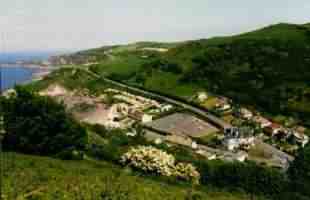 This photograph from Ilfracombe
Museum, shown above (Hele box, ILFCM 17840E), has 1988 written
on the back. It was taken soon after the chalivans at Beachside had been
replaced by caravans.
This photograph from Ilfracombe
Museum, shown above (Hele box, ILFCM 17840E), has 1988 written
on the back. It was taken soon after the chalivans at Beachside had been
replaced by caravans.
(9) Swimming Pools
May 1974 - Ilfracombe swimming pool on Larkstones completed (Bartlett 1995)
Tidal swimming pool built at Hele, probably after Ilfracombe Guide insert advert 1972 (where it is not mentioned), and by photographs c1975, last Ilfracombe Guide mention of pool is 1985. The photograph of the pool, shown above, is from c1975 (used by kind permission of Rev G D Lee)
(10) Hillsborough
1992 - Report for NDDC of Hillsborough studies the flora and fauna and recommends that grazing be re-introduced to counter the invasion of bracken, bramble and other scrub species. Current status Scheduled Ancient Monument, Heritage Coast, Coastal Preservation Area. Presently used for informal recreation, especially dog walking. Unsafe near Beacon Point. Non-intervention would lead to loss of herb-rich grasslands and eventual damage to archaeological site. Principal recommendations are to graze parts of the site and control bracken with poison on other parts of the site. There is also a letter to Jon Green NDDC Parks Dept from Tim Adkin Heritage Coast re 2 further compartments - Hele beach and Rapparee beach and anticipating objection from dog walkers but that an enclosure following the existing wall would be the most suitable for grazing (Herzig 1992)
Hillsborough was managed by the Town Council until the mid 1970’s (and then apparently by a stalwart individual until he died about 1990) The 1992 management plan was used to apply to the countryside Stewardship Scheme which led to Hillsborough being designated as a Nature Reserve in 1993. A new management plan was drawn up in 1993 for 10 years based on the 1992 survey. Hillsborough had already become part of the South West Coast path in 1983 and The Tarka Trail in 1991 (Walls 2000 p8)
In 1993 an article proposed an archaeological dig in the quarry on Hillsborough (which was used 1880-1886 as a sorting station for waste) presumably before the RF mast was erected (Pat Barrow IM Hillsborough folder)
HIGH ‘Hillsborough (Ilfracombe) Group of Helpers’ was formed 1995 by Frank Conian, Joan Miller & others in response to NDDC plans to graze Hillsborough and following a public meeting voicing strong opposition to visual impact of fencing, restrictions on dog walking and problems of poison spreading (and needing 15 days without rain!). HIGH set up to help NDDC manage Hillsborough using mechanical cutting instead. By 2001 this group was almost in abeyance due to lack of members and morale (Joan Miller)
July 1996 Hillsborough 5yr management plan based on 1992 survey but recognising impracticality of grazing and poisoning. Report very biased to operational procedures, cutting, etc, though there is reference to poisoning bracken. (de Lemos 1996)
2000- Report on archaeology of Hillsborough prepared because existing management plan does not take account of the archaeology, principally hillfort, also quarries, lime kiln, gun battery [does not know of Joe Moons cave] Points out that management plan which suggests keeping rabbit warren for grazing conflicts with restriction on causing damage to the hillfort. Ramparts best served by light grazing, here archaeology and wildlife are in accord, but the public are not, suggests that the gun battery is recorded before it is gone, graze if possible otherwise discourage scrub and rabbits from hillfort (Walls 2000)
(11) SWW, Hazel Baker, Seaside Award
In 1994 South West Water installed a pumping station at Hele, to pump effluent to the new treatment works at Larkstone. Two photographs from Ilfracombe Museum, shown above, illustrate the works: one shows the promenade before the pumping station was built (ILFCM 253318) dated 7/7/94, the other shows contractors working on the holding tanks (ILFCM 25331)
2001 - March/April - NDDC repair concrete walls on beach retaining stream
2001 - June/July - Bench sited on the front of the promenade "In memory of Hazel Baker and Tanzi" Hazel lived in Beach Road and was often to be seen on the beach with her dog Tanzi - she used to carry a ball for Tanzi and hit it with a hockey stick.
2002 - March - Hele Beach is awarded a Seaside Award for ‘clean water and good management’. The beach won the award again in 2003.